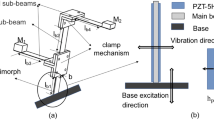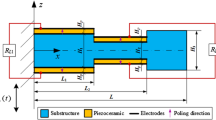Abstract
Compact autonomous power sources are one of the prerequisites for the development of wireless sensor networks. In this work vibration energy harvesting via piezoelectric resonant bimorph beams is studied. The available analytical approaches for the modeling of the coupled electromechanical behavior are critically evaluated and compared with a finite element (FEM) numerical model. The latter is applied to analyze thoroughly the stress and strain states, as well as to evaluate the resulting voltage and charge distributions in the piezoelectric layers. The aim of increasing the specific power generated per unit of scavenger volume is pursued by optimizing the shape of the scavengers. Two optimized trapezoidal configurations are hence identified and analyzed. An experimental set-up for the validation of the proposed numerical model and of the obtained optimized structures is developed. Results of a preliminary experimental assessment, confirming the improved performances of optimized scavengers, are finally given.















Similar content being viewed by others
References
Anton SR, Sodano HA (2007) A review of power harvesting using piezoelectric materials (2003–2006). Smart Mater Struct 16:R1–R21
Beeby SP, Tudor MJ, White NM (2006) Energy harvesting vibration sources for microsystems applications. Meas Sci Technol 17:R175–R195
Brusa E, Carabelli S, Carraro F, Tonoli A (1998) Electromechanical tuning of self-sensing piezoelectric transducers. J Intell Mater Sys Struct 9:198–209
Carson J (1978) Springs design handbook. Dekker
Crandall SH et al (1968) Dynamics of mechanical and electromechanical systems. McGraw-Hill, New York
Crawley E, Hall S (1991) The dynamics of controlled structures, vol 1–3. Technical Course, MIT, Boston
Erturk A, Inman DJ (2008) Issues in mathematical modeling of piezoelectric energy harvesters. Smart Mater Struct 17(6):065016
Erturk A, Inman DJ (2009) An experimentally validated bimorph cantilever model for piezoelectric energy harvesting from base excitation. Smart Mater Struct 18(2):025009
Genta G (1998) Vibrations of structures and machines. Springer, New York
Goldschmidtboeing F, Woias P (2008) Characterization of different beam shapes for piezoelectric energy harvesting. J Micromech Microeng 18:104013
Guyomar D, Badel A, Lefeuvre E, Richard C (2005) Toward energy harvesting using active materials and conversion improvement by nonlinear processing. IEEE Trans Ultrason Ferroelecr Freq Control 52(4):584–595
Helal A, Mokhtari M, Abdulrazak B (2008) The engineering handbook of smart technology for aging, disability and independence. Wiley, New York
Law HH, Rossiter PL, Simon GP, Koss LL (1996) Characterization of mechanical vibration damping by piezoelectric materials. J Sound Vibr 197(4):378–402
Mateu L, Moll F (2005) Optimum piezoelectric bending beam structures for energy harvesting using shoe inserts. J Intell Mater Sys Struct 16:835–845
Paradiso JA, Starner T (2005) Energy scavenging for mobile and wireless electronics. IEEE Pervasive Comput 4(1):18–27
Priya S, Inman D (eds) (2009) Energy harvesting technologies. Springer, New York
Renno JM, Daqaq MF, Inman DJ (2009) On the optimal energy harvesting for a vibration source. J Sound Vibr 320:386–405
Roundy S, Wright PK (2004) A piezoelectric vibration based generator for wireless electronics. Smart Mater Struct 13:1131–1142
Roundy S et al (2005) Improving power output for vibration-based energy scavengers. IEEE Pervasive Comput 4(1):28–36
Shahruz SM (2006) Limits of performance of mechanical band-pass filters used in energy scavenging. J Sound Vibr 293:449–461
Smits JG, Dalke SI, Cooney TK (1991) The constituents equations of piezoelectric bimorphs. Sens Actuators A Phys 28:41–61
Starner T, Paradiso JA (2004) Human generated power for mobile electronics. In: Piguet G (ed) Low power electronics design, chap 45. CRC Press, Boca Raton
Acknowledgments
This work is supported by the “TECH-UP” project for the development of pervasive technologies of the Friuli Venezia Giulia Region, Italy, the “Ultra-high precision compliant devices for micro and nanotechnology applications” project of the Croatian Ministry of Science, Education and Sports and the “Theoretical and Experimental Analysis of Compliant Mechanisms for Micro- and Nanomechanical Applications” project of the Italian Ministry of University and Research. The authors wish to acknowledge also the important contribution of Mr. Elvio Castellarin in the execution of the experimental measurements.
Author information
Authors and Affiliations
Corresponding author
Rights and permissions
About this article
Cite this article
Benasciutti, D., Moro, L., Zelenika, S. et al. Vibration energy scavenging via piezoelectric bimorphs of optimized shapes. Microsyst Technol 16, 657–668 (2010). https://doi.org/10.1007/s00542-009-1000-5
Received:
Accepted:
Published:
Issue Date:
DOI: https://doi.org/10.1007/s00542-009-1000-5




